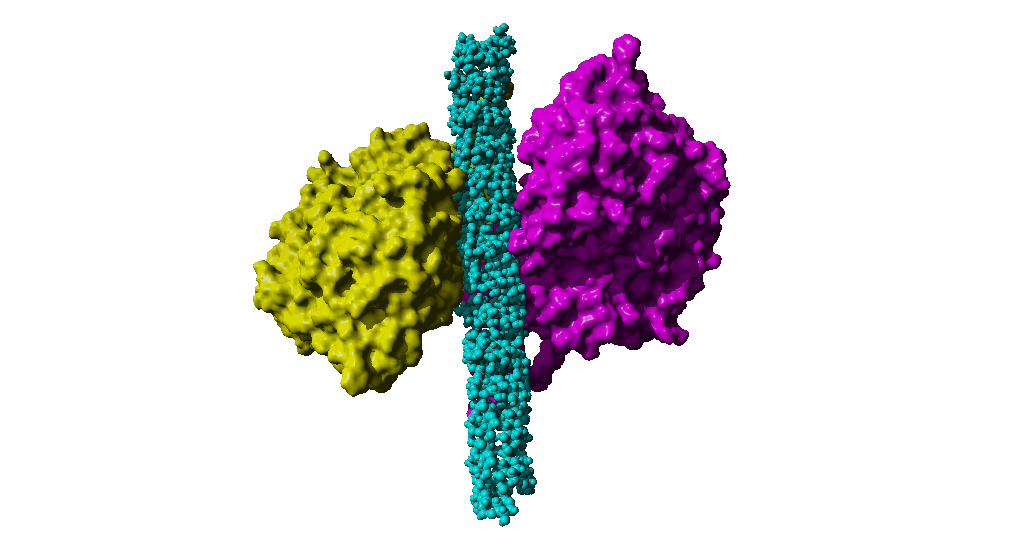The Berndsen lab is interested in two areas: the enzymatic mechanisms of acyl transfer and viral tethering by the protein Tetherin. Lab projects on these topics use a variety of techniques and approaches from measurement of enzyme activity to observing protein structure through X-ray crystallography and computational methods.
We also work with collaborators on and off campus to help answer questions involving protein structure and function.
There are several opportunities for undergraduate students to perform research in the lab both during the academic year and summer, please contact Dr. Berndsen for more information.
A complete list of publications from the lab or on Google Scholar.
We also post data for certain projects on OSF.
The Berndsen lab is also associated with the JMU Center for Genome and Metagenome Studies.

Model and SAXS fit of Legionella VipF from Young, et al., 2016
Enzymatic Mechanism of Acyl Transfer
Cellular proteins are often modified with chemical moieties such as phosphate or methyl groups in order to alter the function of these proteins in response to changes in the environment or during the cell cycle. Two of these post-translational modifications, acetylation and ubiquitination, involve a reaction of a thioester with an amine. While the reaction chemistry is straightforward, the enzymatic mechanism of transfer is not clear and there are a variety of protein structures that can do this chemistry. We aim to determine the catalytic mechanism of these enzymes via biochemical and structural methods to understand:
how substrates bind
the enzyme increases the rate of the reaction
the role of changes in the enzyme structure in the reaction chemistry
how substrate specificity is encoded by the enzyme
Current projects are focused on ubiquitin/ubiquitin-like activating enzymes, cleavage of ubiquitin precursors, and enzymatic modification of protein lysines.
Previous work by the lab on this project:
(undergraduate authors are indicated in bold)
Padala P, Oweis W, Mashahreh B, Soudah N, Cohen-Kfir E, Todd EA, Berndsen CE, Wiener R. Novel insights into the interaction of UBA5 with UFM1 via a UFM1-interacting sequence. Sci Rep. 2017 Mar 30;7(1):508. doi: 10.1038/s41598-017-00610-0. PMID: 28360427
Young BH, Caldwell TA, McKenzie AM, Kokhan O, Berndsen CE. (2016) Characterization of the structure and catalytic activity of Legionella pneumophila VipF. Proteins. Oct;84(10):1422-30. doi: 10.1002/prot.25087. PMID: 27315603
Oweis W, Padala P, Hassouna F, Cohen-Kfir E, Gibbs DR, Todd EA, Berndsen CE, Wiener R. (2016) Trans-Binding Mechanism of Ubiquitin-like Protein Activation Revealed by a UBA5-UFM1 Complex. Cell Rep. Sep 20;16(12):3113-20. doi: 10.1016/j.celrep.2016.08.067. PMID: 27653677

Model of \(\beta\) amylase 2 bound to substrates
Structure and function of \(\beta\) amylase enzymes
In plants, \(\beta\) amylases cleave \(\alpha\) 1-4 linkages between dextrose residues in starch. This enzymatic activity produces maltose which can then fuel other processes in the plant. In Arabidopsis thaliana there are 9 \(\beta\) amylases however little is known about the structure and biochemistry of these enzyme. In collaboration with Dr. Jon Monroe in the JMU Biology Department we are working to characterize the structure and function of these crucial enzymes for plant metabolism
Previous work by the lab on this project:
(undergraduate authors are indicated in bold)
Monroe JD, Pope LE, Breault JS, Berndsen CE, Storm AR. Quaternary Structure, Salt Sensitivity, and Allosteric Regulation of \(\beta\)-AMYLASE2 From Arabidopsis thaliana
Storm AR, Kohler MR, Berndsen CE, Monroe JD. Glutathionylation Inhibits the Catalytic Activity of Arabidopsis \(\beta\)-Amylase3 but Not That of Paralog \(\beta\)-Amylase1. Biochemistry. 2018 Feb 6;57(5):711-721. doi: 10.1021/acs.biochem.7b01274.
Monroe JD, Breault JS, Pope LE, Torres CE, Gebrejesus TB, Berndsen CE, Storm AR. Arabidopsis \(\beta\)-amylase2 is a K+-requiring, catalytic tetramer with sigmoidal kinetics. Plant Physiol. 2017 Oct 24. pii: pp.01506.2017. doi: 10.1104/pp.17.01506.

Simulated pulling of human Tetherin from Ozcan and Berndsen, 2017
Support and Funding
The work of the Berndsen lab is graciously supported by:
National Science Foundation
Jeffress Memorial Trust for Interdisciplinary Research
4-VA organization
Hamilton Syringe Company
U.S.-Israel Binational Science Foundation